
Last modified: 2016-05-13 by pete loeser
Keywords: ufe | unidentified flags | 2015 |
Links: FOTW homepage |
search |
disclaimer and copyright |
write us |
mirrors
Please note our Policy for Submissions and Enquiries.
Below is a series of images of flags that have been provided to FOTW; some we have recognized, and some we have been unable to recognize. If you can help us identify any of these flags, please let us know! Contact the: UFE Editor.
Identification Key:
A TV documentary at the end of 2014 dealt with the present situation of the extreme Right in Britain. It was said that no single organisation was now very prominent and that there were a number of small local groups. These occasionally came together for demonstrations. Footage of such demonstrations showed, usually fleetingly, a number of different flags in use. The majority of these appeared to be standard Union Jacks or St. George's Crosses. However a few were of greater interest – though it was not clear to which group they belonged:
 Image from Wikipedia, 26 February 2015
Image from Wikipedia, 26 February 2015
Speculative modern version of Anglo-Saxon dragon flag. The two-legged dragon or wyvern appears in the death scene of Harold Godwinson on the Bayeux Tapestry depicting the Battle of Hastings in 1066. Image credited to Mafiga
According to Wikipedia the White dragon is a symbol in Welsh mythology, associated with the Anglo-Saxons. The St George flag is seen as some kind of Judaeo-Christian symbol (St George is a Christian Saint), the White Dragon seems to be more connected with the older/pagan/heathen faith.
Dirk Schönberger, 23 February 2015
Perhaps to recall the white dragon fighting the red from Merlin's prophecies.
Will Linden, 23 February 2015
The battle of the red and the white dragon. They occur in a story from I think the 12th century (Sorry, I'm tired.), where the cries from the battle disturb all of Great Britain. It's considered to probably refer to events in the 4th century (likewise). Geoffrey Monmouth mentioned this around the same time, in his History of Britain (which by today's standard doesn't actually contain much history). He places his reference at the time of Vortigern, 5th century, where Merlin tells Vortigern that the Red Dragon represents Vortigern's people, taken to be the (Celtic) British. The white dragon is interpreted as representing invaders. (Can't recall whether Merlin actually says so.) An obvious interpretation is that the White Dragon is the Anglo-Saxon invasion. However, the parallel for the time of the telling was, of course, the battles of the Welsh against the Norman-lead English. Thus, the red dragon comes to represent Wales and the white dragon England. The Red Dragon is now in the Welsh flag, the White Dragon in flags for - let's call it "Englishness".
Merlin is a young boy in that tale, whereas in the more ancient Arthurian myths he's old(er). Maybe that's what inspired Terence White to have his Merlin live backwards.)
As for the similar flag (#2) that may have depicted a wyvern rather than a dragon, it might be from the Bayeux tapestry, I think, shown at the death of the English King Harold II.
Do more have on the design? Relative sizes, known time-span, etc.?
Peter Hans van den Muijzenberg, 23 February 2015
More "ancient" might only relate to the time when stories were created, since the tales of Vortigern are supposed to have taken place before Arthurian myths - there were said to have been several kings after Vortigern's death until the accession of Arthur.
When we consider (#3) we should bear on mind that the British National Party of the 1960's and its present-day namesake are two distinctive organizations - the earlier one eventually became the core of present-day National Front, and the later one was founded by a National Front breakaway group and took a name which might be considered as inherited.
Consequently, that said, flag #3's use by the earlier British National Party does not imply anything about the later one. Also, I found no sources for the flag's use by the original BNP, but it seems to have been used by several later groups founded by its former members, like the National Socialist Movement (again, not connected with the present-day user of the name), or the British Movement (still existing, or re-founded), but it also seems to be sold online without any reference to a particular user.
Tomislav Todorovic, 23 February 2015
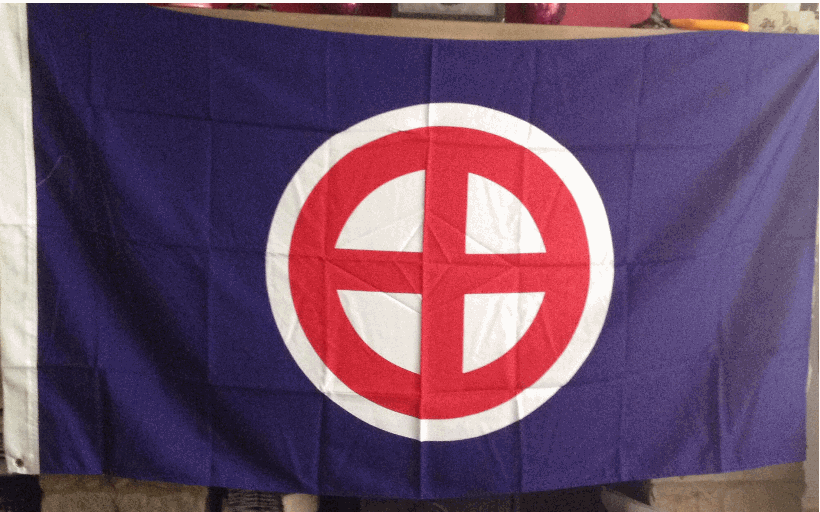 Image from Pete Loeser, 26 February 2015
Image from Pete Loeser, 26 February 2015
As for the blue flag (#3) with a white disc on which is a red cross surrounded by a circle, in the manner of a Celtic cross, but lacking the projecting outer arms, this flag is currently being sold as the "Sunwheel Flag" on what is called the "official" website of the British People's Party, hence it's use at the demonstration shown in the TV documentary.
Pete Loeser, 26 Feburary 2015
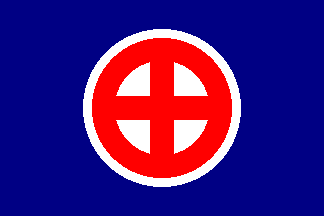 Image by Randy Young, 26 February 2015
Image by Randy Young, 26 February 2015
The design of this flag (#3) looks nearly identical to the "sun cross" flags highlighted on the Neo-Nazi flag Symbolism Page, save for the arrangement of the flag colors. I created a gif of the British National Party flag, using the sun cross flag by Toma as the basis and changing the colors.
Randy Young, 26 February 2015
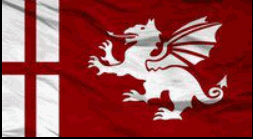 Image from Pete Loeser, 26 February 2015
Image from Pete Loeser, 26 February 2015
Could the White Dragon flag (#1} in question be that of the English People's Party? I don't know if they are extremist, however.
Pete Loeser, 26 February 2015
I am not sure if the English People's Party exist outside the Facebook, either - a Google search revealed next-to-none info.
Tomislav Todorovic, 26 February 2015
Flag (#5) is the design for the British Union of Fascists (BUF) in FOTW.
Flag (#4) differs only in the fact that the blue disc is larger than the white emblem and so is, as it were, superimposed directly on the red field rather than being separated from it by the white circle of the emblem.
The image of the "Sun wheel flag" is indeed the same as the (#3) in the TV documentary. I had looked at the "Wikipedia" entry for the British National Party which did not include an image, but which did make the significant point (previously unknown to me) that the BNP of the 1960s was not the same organisation as the later one of that name, which used a different flag as shown in FOTW.
The other image with the white dragon, does indeed resemble the flag (#1) in the documentary; it was shown for such a short time that I cannot recall whether or not there was a St. George's Cross on that flag. I have not heard of the English People's Party until you mentioned it, so I do not know whether or not its ideas might be considered extreme.
Two other points emerged from "Wikipedia". They show the BUF flag with a central disc that is definitely blue, not black, and they also depict a black and gold flag in a different design that is not in FOTW.
Kenneth Fraser, 27 February 2015
This flag was identified as that of the Union of Right Forces.
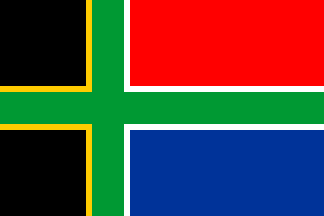 Image from Tomislav Todorovic, 1 March 2015
Image from Tomislav Todorovic, 1 March 2015
The Citizen Alert Za blog shows this flag which is clearly derived from the national flag of South Africa: green Scandinavian-type cross, fimbriated yellow at the hoist side and white at the fly side, which divides the field into two black fields (hoist) and one red (top fly) and one blue field (bottom fly). The color shades are the same as those of the national flag. The file name of the image [see above] suggests that the flag is used by a corporate body whose name is abbreviated MMC, but I was not able to find any information about such an entity on the Web, so this shall be taken with reserve. Any idea whose flag this might be?
Tomislav Todorovic, 1 March 2015
Does de abbreviation MMC might actually be Roman numerals? Just a wild guess...
Esteban Rivera, 1 March 2015
I don't think so - I cannot see any connection to the number 2100.
Tomislav Todorovic, 2 March 2015
There is a South African Christian Mens Conference called the "Mighty Men Conference". The photo, especially with the file name clue, looks like it was taken at an MMC event, and indeed at there is a photo of an MMC event including such a flag. It is not intended as a flag for the MMC specifically, but as a general South African Christian flag, simply combining a cross with the national flag. The blog Ferdi Vertel mentioned it in 2010. Using the Google Translator, it says: "How do you like this redesign of an old flag? I think it can help Christians to stand together and to trust God for miracles for our country".
Jonathan Dixon, 3 March 2015
That photo looks like a smaller and horizontally flipped version of the first reported one.
Tomislav Todorovic, 3 March 2015
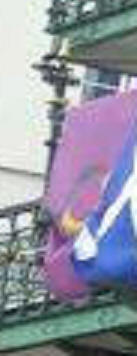
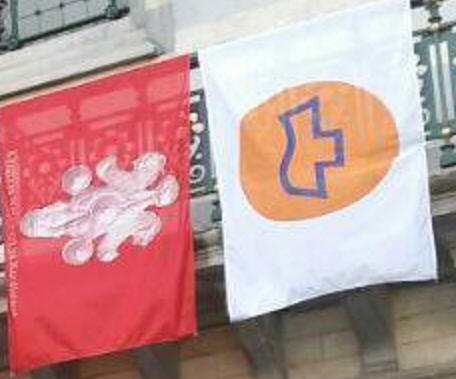 These flags have all been identified and placed in the database as:
These flags have all been identified and placed in the database as:
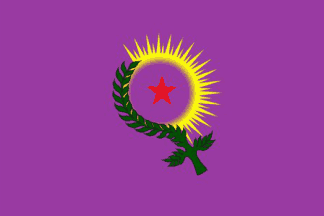 The flag of the Kurdish Women's Movement.
The flag of the Kurdish Women's Movement.
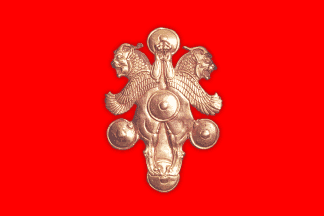 The flag of the the Kurdish National Congress.
The flag of the the Kurdish National Congress.
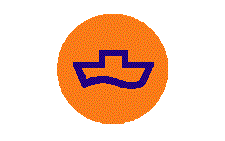 The flag of Woman on Waves.
The flag of Woman on Waves.
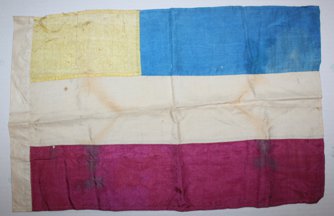 Image from George Glastris, 1 April 2014
Image from George Glastris, 1 April 2014
I believe this small silk flag to be of Chinese origin as it came with an early Dragon flag as well as a KMT Nationalist flag from the estate of a man who was in China from the 1860s-80s. Any help you could give me would be wonderful.
George Glastris, 1 April 2014
Maybe this one was found in China, however, it appears to be the Civil Ensign (1865 and 1866) - a provisional merchant flag of the Duchies of Schleswig and Holstein.
Klaus-Michael Schneider, 3 April 2015
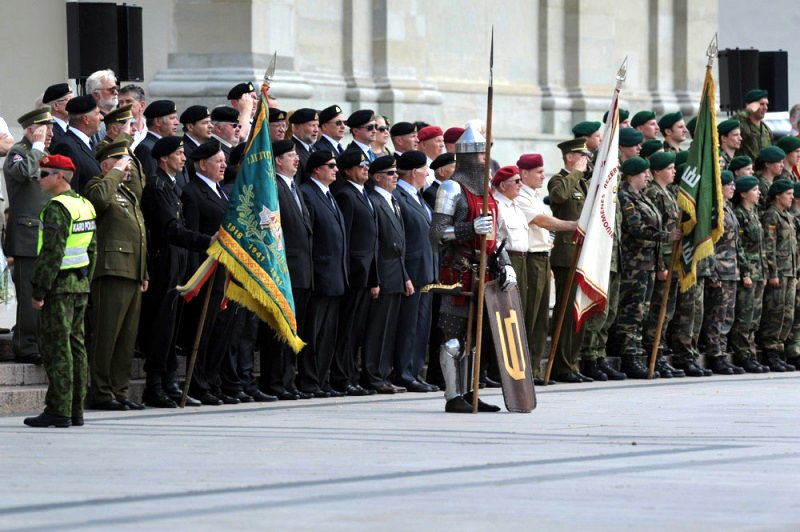 Image from Esteban Rivera, 1 April 2015
Image from Esteban Rivera, 1 April 2015
In this link of the official website of the Ministry of National Defence of the Republic of Lithuania, titled "Major General Jonas Vytautas Žukas was inaugurated as Chief of Defence of Lithuania for a five-year tenure at a formal ceremony at the Cathedral Square of Vilnius, 24 July, 2014", one can see this picture with three military flags during this parade. Can someone help identify them?
Esteban Rivera, 1 April 2015
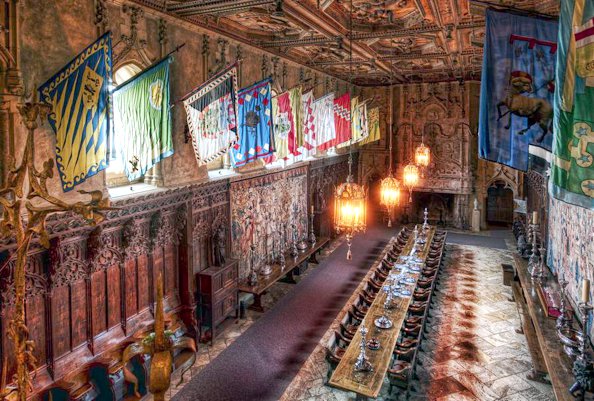 #22a
#22a
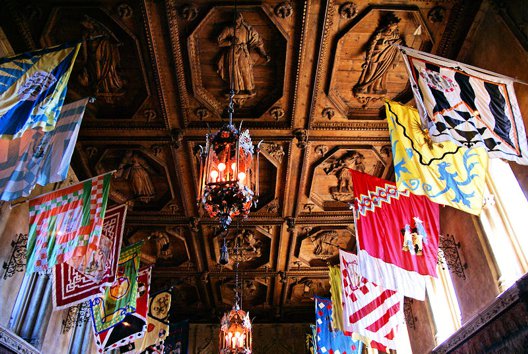 #22b
#22b
Images from Bishop Lamoureux, 15 April 2015
In Hearst Castle, a historical landmark and state park located on the Central Coast of California, there is a collection of flags hanging over the dining room. I personally cannot find anything that relates to these flags that is contemporary. It is entirely possible these flags are all made up. The closest thing I can find is this one which looks like one in the second picture (#22b), the fourth one on the left. I am pretty sure they are unrelated though. Does anybody recognize any of these flags?
Bishop Lamoureux, 15 April 2015
These are Siena Ward flags. Or rather, they are replicas of the original banners that are part of Hearst's collection.
See Palio Flags for a first introduction, though I expect none of these medieval banners will match the current ones. The banners seem to change over time, plus through the years quite a number of wards have disappeared. (There would even be some logic in these specifically being banners of wards that no longer exist.)
It would still be interesting to get good images, though, as they show more of the history of the Sienna ward banners.
Peter Hans van den Muijzenberg, 15 April 2015
It seems commonplace for these Palio flags to be displayed indoors in several places around the world. For the full list of Contrade, please see Contrade of Siena and also note the pictures captioned "Flag of Onda contrada hanging in the cathedral of Siena" and "Flag of Onda contrada hanging in the cathedral of Siena" on the same page. It is interesting to point out is that "Palio" in Italian means "Standard" (as derived from the word "stick", thus, having a banner hanging from a stick or pole, since "Palo" in Spanish, and perhaps "palum" in Latin, means "stick"). The Palio Flags derive from a horse race.
Sources: Palio di Siena and the Official Siena Website.
Esteban Rivera, 15 April 2015
I've already posted the short identification that these are Siena ward flag. (Well, they are replica's, but the originals are supposed to indeed be in Hearst's collection.) It took a while to gather recognisable images of most of the flags, though. But now, here goes:
Counter to my original understanding, these don't seem to be really ancient flags, possibly from no longer existing wards. Rather, most may have been flags from a few years prior to the time Hearst acquired them.
On the wall to the left of the camera in 22a are:
- Tartuca ward
- Bruco ward
- Lupa ward
- Nicchio ward
- Drago ward
- Giraffa ward
- Onda ward
- Torre ward
- Aquila ward
- Lupa ward
- Bruco ward
All of those are indeed visible in image 22a. Image 22b is in the other direction, showing the flags from the last to the first, with Bruco ward not in view, above or behind the camera, and the far Lupa ward flag obscured by the Nicchio ward flag
in front of it.
On the wall to the right of the camera in 22a are:
- Bruco ward
- The Lamb of God.
- Lupa ward
- Aquila ward
- Civetta ward
- Bruco ward
- Giraffa ward
- Selva ward
- Onda ward
- Tartuca ward
- Oca ward
- I-don't-know-which ward
In image 22a, only the first two are plainly visible. Because of the shape of the banner showing the Lamb of God, a part of the Lupa ward flag is visible underneath it. Also, as it's also a rather fine material, a bit of the Aquila ward flag is just visible though the material. Image 22b is in the other direction, and shows the flags from the last to the first, except that the Tartuca ward flag is the first visible one, with the two before it being above or behind the camera, and the Bruco ward flag is obscured by the larger Lamb of God banner in front of it.
Several wards make more than one appearance in these two lists. This is correct, as they are indeed present with several flags. Each flag is of a different design, though. What remains the same are the colours and the arms, which are the features that identify the ward. Curiously, approximately 2012 the order in the second list seems to have changed, in that the two Bruco ward flags switched places, as did the Selva ward and Oca ward flags. As 22b (and therefore matching 22a is apparently older than that, see web archive of dinning room photo) , the flags are no longer exactly in the order shown in the photographs and given in the list above.
I don't think the banner showing the Lamb of God is a ward flag. It appears to be different in shape, in material, in style and in imagery. If it really has to belong to a ward, it would fit somewhat with Valdimontone ward, but it would mean they have completely changed their style since then. I don't think that is it.
The I-don't-know-which ward flag took me the longest, as it's in the corner on the side away from the main entry and the balcony, thus it's almost always obscured or above or behind the camera. When I finally found a photograph showing it, I found it really looks like just another ward flag, but it has no central charge. It just has shields at the top and bottom corner. Well, maybe with an even better photograph, showing the obverse to be sure, I might recall where I saw those particular shields before. For now, if I would have to hazard a guess, I'd give it to Bruco ward, but please ask all relatives who mention Hearst Castle if they can take a good photograph of this one.
That's as far as I can bring it. Please, contact any connections you have with Hearst Castle or Siena, but for now these last two remain unidentified, with a very small amount of speculation.
Peter Hans van den Muijzenberg, 18 August 2015
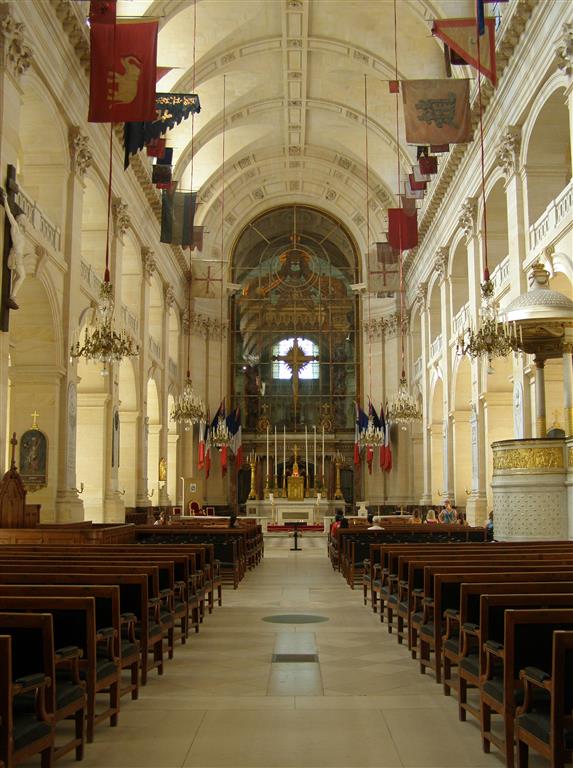 A discussion of this collection of military flags on FOTW has been moved to Flags of Saint-Louis-des-Invalides Cathedral.
A discussion of this collection of military flags on FOTW has been moved to Flags of Saint-Louis-des-Invalides Cathedral.
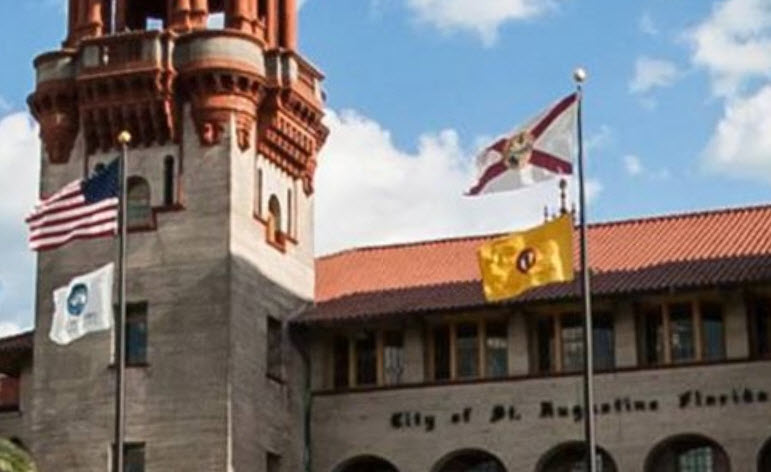 Image from Esteban Rivera, 15 April 2015
Image from Esteban Rivera, 15 April 2015
In this picture one can see two flagpoles from left to right, bearing four flags in total:
- First flagpole (from left to right): US flag on top, UFE (#1) on the bottom.
- Second flagpole (from left to right): Florida State flag, UFE (#2) on the bottom.
Can anyone identify these flags?
Esteban Rivera, 15 April 2015
Number #2 might be Sinister St. Augustine?
Peter Hans van den Muijzenberg, 15 April 2015
I thought it might be the St. Augustine flag, but I'm not sure. Still, there is one more flag to identify (#1), since there are four flags in this picture.
Esteban Rivera, 15 April 2015
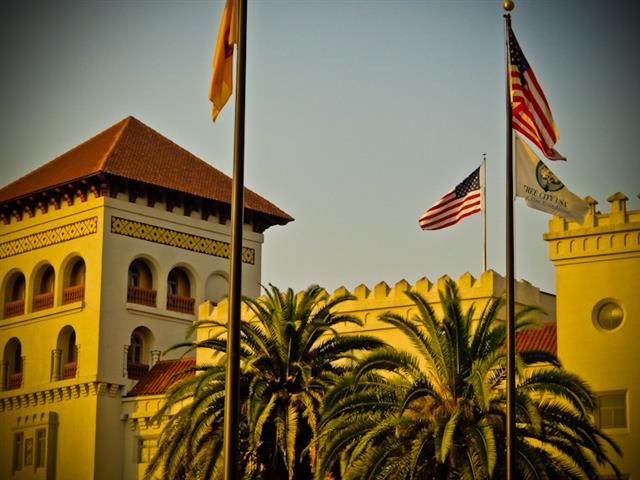
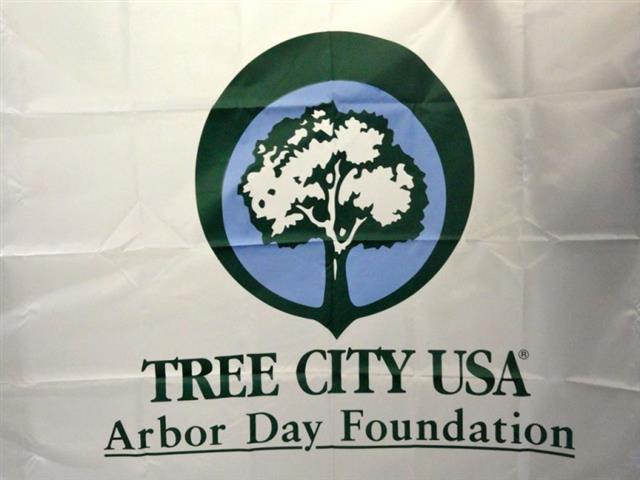 Images from John Yogis, 11 May 2015
Images from John Yogis, 11 May 2015
I believe I can positively identify both of the UFE's in question. The first unidentified flag is the white flag charged with a circle with a tree on it flying beneath the national flag of the United States. This flag can be positively identified as that of the "Tree City USA" program as sponsored by the Arbor Day Foundation. Attached please find two pictures: the first picture is of the same flags from a different perspective at Flagler College, and the second is the detail of the Tree City USA flag in question. A page about the Tree City USA program can be found on the Arbor Day website.
The second unidentified flag, the one positioned below the state flag of Florida, is indeed the flag of St. Augustine as Peter had speculated. You already have an established FOTW page for the city.
John Yogis, 11 May 2015
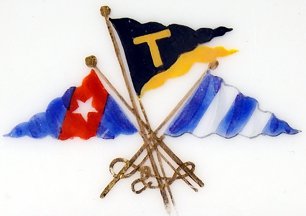 Image from Lee Berkovits, 29 April 2015
Image from Lee Berkovits, 29 April 2015
I have a set of plates with nautical pennants that I have not been able to identify. I would be most appreciative of any help you might be able to provide. These are marked on the back both "Cauldon/England" and also with an importer's mark for "Higgins & Seiter" of New York.
Lee Berkovits, 29 April 2015
Two of the burgees are probably the Eastern Yacht Club of Massachusetts (dexter), and the Larchmont Yacht Club of New York (sinister). The upper flag would then be the private signal of the yacht owner whose yacht(s) this crockery was made for, someone who was a member of both of those yacht clubs.
Now, here comes the problem: The Eastern is from 1870, and the Larchmont is from 1880, and both of them still exist. That's quite a long history to check for. Higgins & Seiter, appear to have been in business from 1860 to 1915, however, whereas Cauldon seem to have started using the name around 1890. Together these would somewhat limit the time frame: Ca. 1890 - 1915.
Often, such private signals are listed in the Lloyd´s registers. In this case I was able to check scans of the Lloyd´s Register of American Yachts 1902-1903, 1905-1906, and 1906 editions, but was unable to find this signal. Checking a scan of The American Yacht List 1891 - plus scans of the 1886 and 1885 editions to be sure - yielded the same result.
I´m afraid that for the moment I´ve run out of sources to check for the private signal. The course for further action, I would say, would be to contact both clubs to determine whether their membership registration go back far enough to allow checking for yacht owner who was a member of both clubs at the same time, to at least get a likely owner of this particular signal.
Peter Hans van den Muijzenberg, April 2015
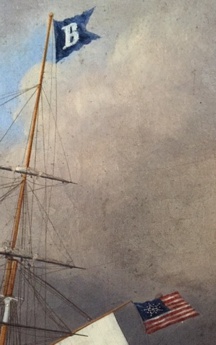 Image from Scott Hubbard , 7 May 2015
Image from Scott Hubbard , 7 May 2015
I have a Mid 19th century ship portrait painting of what appears to an American ship (3 masted barque) as it has the "Grand Luminary Star" flag. It has a swallow tail Burgee with a white "B" on a blue background which I can't identify. The ship is unnamed. The back of the canvas has a Broadway New York stencil.
Scott Hubbard, 7 May 2015
This looks like a Bethel flag. To paraphrase the FOTW page: "Floating churches called Bethels, were started in London and vicinity about 1814. The Bethel flag first appeared in the United States on a vessel entering New York harbor in March 1821. The Bethel movement supplemented the activities of the Navy chaplains in ministering to the spiritual needs of naval personnel."
Pete Loeser, 9 May 2015
The Colors are dead on. Blueback ground with white letter B. The time period is right - Mid-19th century or so. Good spotting!
Scott Hubbard, 9 May 2015
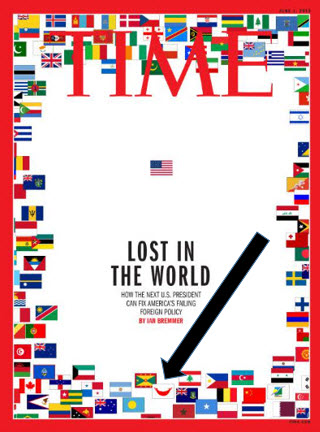 Image from Miles Li, 24 May 2015
Image from Miles Li, 24 May 2015
[black and green locator arrows added by UFE Editor]
On the latest issue of TIME magazine (outside North America) the cover shows a large number of flags. At the bottom there is a white flag bearing a red banana-like object [black arrow], which I cannot identify. Perhaps it is the flag of some remote island territory - any ideas?
Miles Li, 24 May 2015
The white flag with a red object is the flag of Easter Island, which is Rapa Nui in Polynesia. The flag is called the Reimiro flag, and the object is a decorative crescent-shaped pectoral ornament worn as an insignia of high rank.
Ralph Kelly, 24 May 2015
I see the explanation of the flag of Easter Island on the TIME Front Cover, but I also see another white flag which I can't identify on the same cover. A white flag (with something blue, green, and yellow object) is located between the flags of Syria, China, South Korea, Singapore and Qatar at the lower right corner of the TIME cover [green arrow]. Perhaps it's the flag of some country's overseas territory, I think. Do you have some information?
Hikaru Isobe, 14 August 2015
 Fair use image from Wikipedia, 15 August 2015
Fair use image from Wikipedia, 15 August 2015
That is the emblem of the region of Guadeloupe, apparently commonly used on a white flag. [This is now the official flag of Guadeloupe, based on the official logo of the regional council.] I didn't find any mention of it on our website.
Jonathan Dixon, 15 August 2015
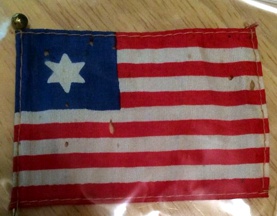 Image from Clayton Horner, 5 June 2015
Image from Clayton Horner, 5 June 2015
I found this on eBay the other day. It was being sold as an American flag. Since it has 11 stripes and one star, I think it is Liberian. The only thing I cannot figure out is why a six pointed star.
Clayton Horner, 5 June 2015
I have mentioned this before, but in most African cultures, a star is a star, just the same is a color is a color. It makes no difference how many points the star has. If someone in Liberia started making Liberian flags with 6 pointed stars, most people would not notice.
The thing that interests me is the fact that the flag is so small. With the exception of South Africa, no one in Africa that I am aware of mass produces really small stick flags. If they did, this would not be a surprising flag. That aside, I wonder if the flag isn't western made and some one simply had bad information on the "official" specifications for Liberia's flag.
Clay Moss, 13 June 2015
Since the flag has eleven horizontal stripes (as opposed to thirteen), a canton covering the first five of those stripes (rather than seven), and a single star (not fifty), without any doubt it is Liberian.
Christopher Southworth, 13 June 2015
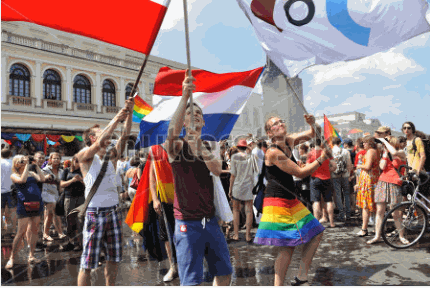 Image from Pete Loeser, 12 June 2015
Image from Pete Loeser, 12 June 2015
Does anybody recognize the white flag in this LGBT demonstration? I'd guess it was in Luxembourg or The Netherlands, based on the red-white-blue horizontal striped flag.
Pete Loeser, 12 June 2015
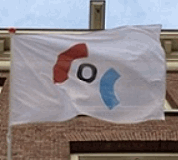 Image from COC Nederland, 8 July 2015
Image from COC Nederland, 8 July 2015
It is the flag of COC Nederland, the main Netherlands LGBT organisation.
Jeroen van Leeuwen, 7 July 2015
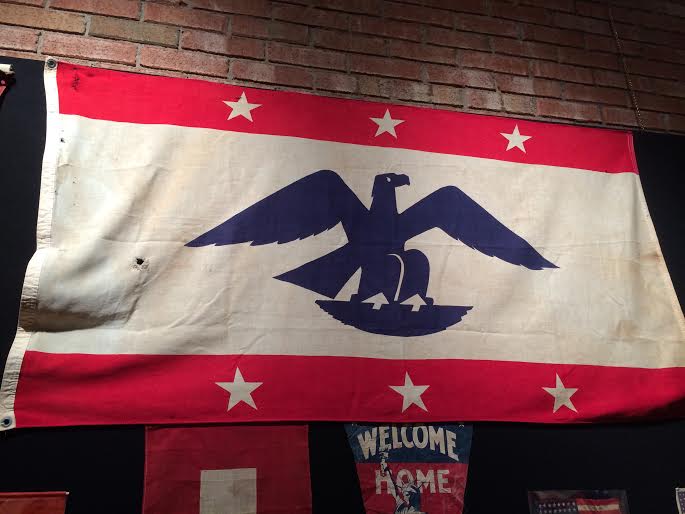 Image from Jim Ferrigan, 14 June 2015
Image from Jim Ferrigan, 14 June 2015
Here is an unidentified World War II era cotton flag I have never seen before.
Jim Ferrigan, 14 June 2015
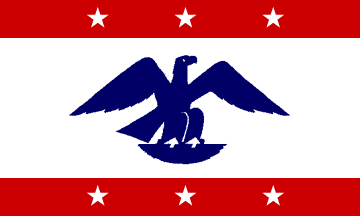 Image from António Martins-Tuválkin,, 7 April 2016
Image from António Martins-Tuválkin,, 7 April 2016
Sadly I have nothing to add that could help in the identification, besides the obvious question: Can it be safely assumed that this is an U.S. item at least, or nor even that? Where was the photograph taken?
António Martins-Tuválkin,, 7 April 2016
The US weather flag and the Welcome home to the Statue of Liberty as well as two American flags that are below the flag, in the picture, do suggest this flag indeed has to do with the US.
Peter Hans van den Muijzenberg, 9 April 2016
Does anybody have the URL of this image submitted by Jim Ferrigan? Or at least the source and/or website? It'd be easier with that tip to start looking. However, when looking for those keywords, "World War II welcome home flag", one can find very interesting things. For instance, as mentioned by António Martins-Tuválkin and Peter Hans van den Muijzenberg, this is indeed an American flag, judging by the other two flags in the picture, namely wig-wag flags as seen on the left (source) and on the right, one of the multiple variants of the "welcome home" flag.
In fact, the "welcome home" type of flag can actually have a set of distinctive marks (horizontal flag in shape, with three stripes (or sometimes a red square too), two red which are top and bottom and the middle is white, plus an eagle in he middle and the use of star (or stars) either in the middle of the flag or in the top and bottoms stripes, as the specimen we have.
This image shows another version featuring a colored eagle with blue star in the middle. In fact it is cardboard, but in the description of the item, it mentions it is a banner indeed: The message on the sign front reads "Banner used to welcome a Staten Island member of the Fighting IRISH RGT commanded by Col Wm Donovan. Donovan won the Congressional Medal of Honor with the RGT and went on to head the OSS in WWII."
The back is written in quill pen states "Corp Frank Brandreth, Co B Purple Heart & Croix de Guerre ( Shrapnel 9/18 and gas 10/18 Argonne). The 10.5 x 14 inch sign has some stains as shown."
(Source)
Esteban Rivera, 18 April 2016
Last night, a Spanish channel of American TV reported a gathering of Cuban and Venezuelan dissenters in New York and Miami. I had never seen this flag. It looks like a mixture of the Russian naval ensign and the Cuban flag. Does anybody know about this flag?
Art, 13 July 2015
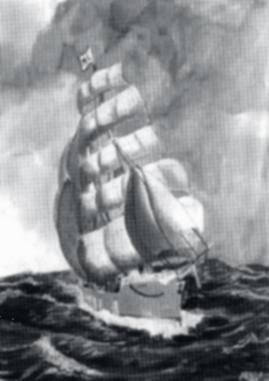 Image from Esteban Rivera, 14 July 2015
Image from Esteban Rivera, 14 July 2015
In this picture is a Spanish vessel christened as the San Ignacio de Loyola (a.k.a. El Glorioso - "The Glorious"). In the picture, it shows a flag on its highest mast, bearing the letters ML (in capitals). The ship is classiffied as bergant ín (brigantine), goleta (schooner) and even petrolero (oil tanker). Does anyone know what the flag stands for?
For further reference on this ship, I found the following sources (all of them in Spanish, but no mention of the "ML" riddle): Vidamaritima, ANTXO, and AHCM.
Esteban Rivera, 14 July 2015
Viuda de Londaiz y sobrinos de L. Mercader, S.A. Sociedad mercantil constituida en San Sebastián (Guip.) en 1883 para la "compra, refinación, expedición y venta de petróleo y cualesquiera otros aceites minerales". Hasta el fallecimiento de Luciano Mercader en 1914 se denominó "L. Mercader y Viuda de Londaiz". Se transformó en Sociedad Anónima en 1983. (Source: Eusko Media)
It is probably some kind of houseflag of Mercader y Londaiz, and it appears the company still exists, but I have no coloured image of the flag.
Klaus-Michael Schneider, 14 July 2015
Do we have this house flag featured in House Flags of Spanish Shipping Companies?
Esteban Rivera, 14 July 2015
Unfortunately not. I haven't found a match in any flagbook of shipping companies I know. Thus I am not even able to tell you about the colours. It appears the successor is a chemical company, but still located in San Sebastian.
Klaus-Michael Schneider, 14 July 2015
 Image from Banderak Itxasoan - Flags at Sea website, 15 July 2015
Image from Banderak Itxasoan - Flags at Sea website, 15 July 2015
The information about L. Mercader y Vda. de Londaiz done by Klaus-Michael is correct, but the vessel San Ignacio de Loyola was a brigantine, oil carrier, but not oil tanker. You can see the coloured house flag at the Banderak Itxasoan website page.
Aingeru Astui Zarraga, 15 July 2015
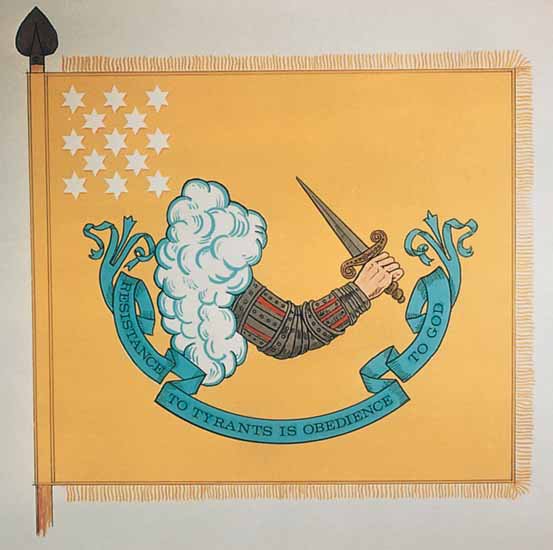
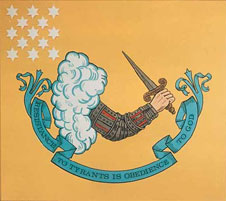 Images from Pete Loeser, 17 July 2015
Images from Pete Loeser, 17 July 2015
Does anybody have any information of this Revolutionary "Resistance to Tyrants is Obedience to God" Flag. I could not find it on our database. Apparent it is found in the Library of Congress collection. Image Sources: George Washington: A National Treasure and Foundation Truths.
Pete Loeser, 17 July 2015
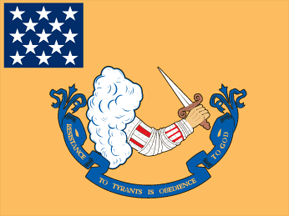 Corrected image by Rick Wyatt, 17 July 2015
Corrected image by Rick Wyatt, 17 July 2015
That is the Gostelowe Standard No. 10. - Major Jonathan Gostelowe listed 13 standards in an inventory conducted in 1778 for the Continental Army, and this is one of them. In 2005, the actual flag was sold, as one of four, by Sotheby's auction. They came from the private estate of the heirs of Lt. Col. Banastre Tarleton, a Revolutionary War era British officer. It was discovered that the stars and union was different from those originally illustrated by Major Gostelowe.
Rick Wyatt, 17 July 2015
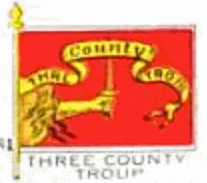 Image from Steve Shumaker, 19 July 2015
Image from Steve Shumaker, 19 July 2015
On page 339 of the 1917 National Geographic Society's Flags of the World shows the image (#381) of the Three Company Troop. The flag has a red background with yellow streamer like scroll with "Three County Troop" with an arm coming out of a cloud holding a sword aloft. On Page 345, the same book indicated that the Three County Troop was a cavalry company (troop) raised from three Counties (Middlesex, Essex, Suffolk) in Massachusetts Bay Colony in 1659. The Troops operated for 20 or more years and most likely served in King Philip's War in 1675 & 1676. The source for this flag is a drawing in which Troop is misspelled as "Trom") and original bill at the British Museum.
According to our Bedford Militia Flag page, the flag was granted in 1661-1662 "Similarity to sketches of a flag made soon after 1660 for another Massachusetts cavalry, the Three County Troop,...."
Steve Shumaker, 19 July 2015
This flag has been identified as an ISIS Camp Flag and is now located in its permanent location.